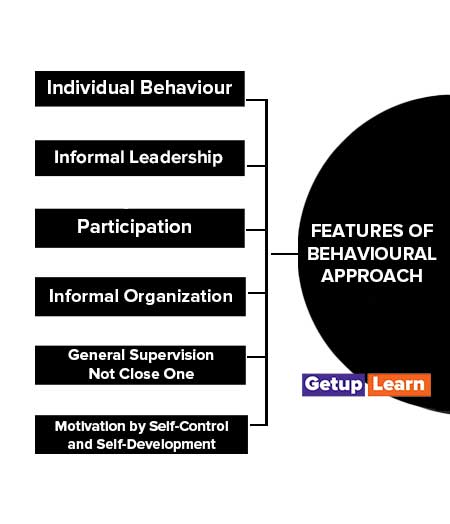Table of Contents
What is Behavioural Approach?
The Behavioural approach concerns itself with the social and psychological aspects of human behaviour in an organization. The behaviour of members of an organization clearly affects its structure and functioning as well as the principles on which it can be managed.

Behavioural research has provided sufficient evidence that the human element is the critical factor in the success are failure of an organization. Several experiments have observed that people prefer to be consulted rather than receive orders or information.
Features of Behavioural Approach
Less reliance on the use of authority is preferred. Some of the more important elements or features of behavioural approach may be outlined as follows:
- Individual Behaviour
- Informal Leadership
- Participation
- Motivation by Self-Control and Self-Development
- Informal Organization
- General Supervision Not Close One

Individual Behaviour
Individual behaviour is closely linked with the behaviour of the group to which he belongs. The group dictates changes in his behaviour. Individuals observe those work standards which are prescribed by the group.
Informal Leadership
Informal leadership, rather than the formal authority of managers is more important for setting and enforcing group standards of performance. As a leader, a manager may be more effective and acceptable to subordinates if he adopts the democratic style of leadership.
Participation
If the subordinates are encouraged and allowed to participate in establishing goals, there will be a positive effect on their attitude towards work.
If employees are involved in planning, designing the jobs and decision-making, there will be the least resistance to changes effected in technology and work methods.
Motivation by Self-Control and Self-Development
Behavioural scientists maintain that by nature most people enjoy work and are motivated by self-control and self-development. Managers should try to identify and provide necessary conditions conducive to the proper and sufficient use of human potential.
The managers’ attitude towards human behaviour should positive. They should know that the average man is not lazy by nature. But he is ambitious. Every man likes to work and prefers to assume responsibilities.
Macgregor maintains that employees favour self-direction and self-control. Behavioural scientists believe that in place of the concept of social man the concept of self-actualizing man would be more appropriate to explain human motivations.
Chester I Bernard pointed out that material reward is of crucial signification only up to a definite point. The incentives of status, power, good physical conditions opportunities for participation and good social (i.e., cultural interrelationships) are very important.
Informal Organization
Behavioural scientists particularly Bernard, consider informer organization as an essential part of the formal organization. Informer organizations must always be taken into account while determining managerial behaviour.
General Supervision Not Close One
As regards supervision of subordinates, Behavioural scientists particularly Likert, are not in favour of close supervision. They advocate general supervision, which tends to be associated with high productivity.
Assumptions of Behavioural Approach
The Behavioural approach is based on certain assumptions about man and organization, which may be looked upon as their prepositions (statements of opinion or judgement) also. These are the following assumptions of behavioural approach:
- The organization is a socio-technical system involving people and technology as its primary components.
- The behaviour of the members of an organization clearly affects its structure and functioning, as well as the principles on which it can be managed.
- An individual’s behaviour is closely linked a greatly influenced by the behaviour of the group to which he belongs.
- A wide range of factors influences the work and interpersonal behaviour of people in the organization.
- Congruence (agreement) between organizational goals and individual goals of organization members would be established.
- Several individual differences in perceptions, aspirations, needs, feelings, abilities and values of people excited in the organization, such differences along with their changing nature over periods of time have to be recognized.
- Informal leadership rather than the formal authority of supervisors is more important for an increase in employee performance.
- Democratic leadership and participative managerial styles encourage employees’ positive attitudes towards work and faster high morale and initiative among them.
- By nature, most people enjoy work and are motivated by self-direction, self-control and self-development.
- Conflict in the organization may sometimes be inevitable and even desirable for development, innovation and creativity in some instances. Conflicts and cooperation coexist in organizations.
Conflicts are not to be suppressed but are to be resolved and that too not always, coordinated is vital for the achievement of organizational goals. The above prepositions are important elements of Behavioural science thinking. Thus the Behavioral approach represents a significant advance over the human relations approach.
Use of Behavioural approach
These are the use of behavioural approach:
- It is easy to put into practice.
- It is simple to understand.
- The results are usually quick.
- It uses small steps to shape the behaviour.
- It doesn’t require a specialist to implement it – anyone can use the approach.
- It is based on the principle that reinforced (rewarded) behaviour will be repeated.
- The results can be measured and demonstrate progress.
- It is suitable for any age and ability.
Limitations of Behavioural Approach
These are the limitations of behavioural approach:
- Not always easy to get people to change their minds.
- The client may rebel against being told what to do.
- Older people may resent being ‘treated like a child’.
- It doesn’t consider the client’s thoughts or feelings.
- It may be seen as dogmatic and punishment.
- Punishment is often used more frequently than rewards.
- Could be seen as dehumanising – reducing our behaviour to responses to stimuli.
- Suggests that we are only pleasure-seeking animals,
What are the features of behavioural approach?
The following are the features of behavioural approach:
1. Individual Behaviour
2. Informal Leadership
3. Participation
4. Motivation by Self-Control and Self-Development
5. Informal Organization
6. General Supervision Not Close One.
What is the use of behavioural approach?
The following is a use of behavioural approach:
1. It is easy to put into practice.
2. It is simple to understand.
3. The results are usually quick.
4. It uses small steps to shape the behaviour.
5. It doesn’t require a specialist to implement it – anyone can use the approach.
6. It is based on the principle that reinforced (rewarded) behaviour will be repeated.
7. The results can be measured and demonstrate progress.
8. It is suitable for any age and ability.
What are the limitations of behavioural approach?
The following are the limitations of behavioural approach:
1. Not always easy to get people to change their minds.
2. The client may rebel against being told what to do.
3. Older people may resent being ‘treated like a child’.
4. It doesn’t consider the client’s thoughts or feelings.
5. It may be seen as dogmatic and punishment.
6. Punishment is often used more frequently than rewards.
7. Could be seen as dehumanising – reducing our behaviour to responses to stimuli.
8. Suggests that we are only pleasure-seeking animals.
















